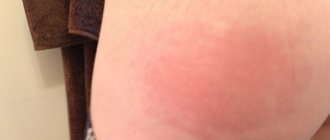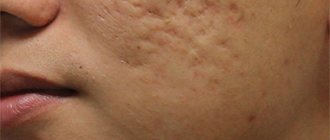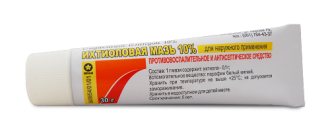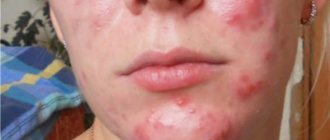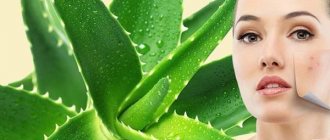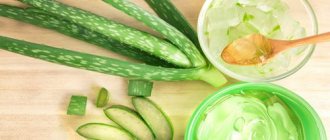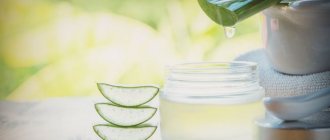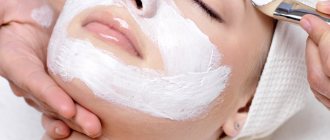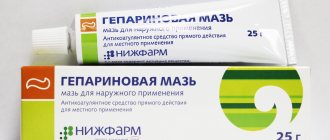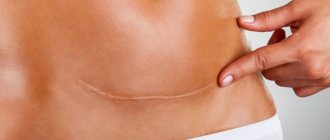How does aloe affect skin formations?
Aloe is a common house plant in the form of a flowerpot, the benefits of which are enormous. Its juice has bactericidal, antiseptic, analgesic, regenerating and stretching properties on inflamed areas of the skin, destroys pathogenic bacteria (streptococci and staphylococci), cures purulent formations, lipomas, abscesses, and heals wounds.
Algorithm of action on boils and wen: when the plant comes into contact with an abscess, it accelerates ripening and helps to remove the contents faster. Aloe for boils effectively removes redness, muffles the inflammatory process, neutralizes itching and pain, and normalizes body temperature.
Reviews about the plant make it a panacea for the treatment of purulent diseases; it can treat many skin lesions. The remedy is effective only for isolated manifestations of boils. If the problem is chronic, you need to determine its cause and carry out appropriate therapy.
If there is no positive result from home treatment within three days, you need to contact a specialist to prevent possible consequences (infection growth or blood poisoning).
Why does furunculosis occur?
The main culprits of such a disease as furunculosis are called staphylococcal bacilli. They get on the skin and, when the opportunity arises, penetrate into the cellular composition. If a person’s immunity is strong, then it defeats bacteria. When weakened, bacteria intensify their development. Growth and reproduction leads to the appearance of furunculosis, and treatment is delayed.
When contacting specialists, the reasons are found out, and treatment is prescribed in accordance with them:
- the skin tends to be oily, but people don’t pay attention to it. Does not look after properly;
- due to the sensitive type of epidermis there is a tendency to problems such as dermatitis and eczema;
- Hormone failure or organ dysfunction;
- the immune system has malfunctioned and reduced its protective functions;
- diabetes mellitus and other metabolic disorders.
When it begins to appear, furunculosis is similar to ordinary acne, or takes the form of a boil. It is quite easy to get rid of if you treat it with clean hands with antiseptics and antimicrobials. But after some time, instead of one, several abscesses appear, and more serious drug treatment is required. Moreover, you can also do it yourself, but it’s still better to seek help from specialists. There is a second way out - traditional medicine.
Instructions for using aloe for boils
Before preparing any aloe-based remedy for boils, we adhere to the following rules:
- Only fresh leaves of the plant.
- Do not use large or small shoots; it is optimal to choose medium-sized leaves.
- We cut off the plant with a well-sharpened knife and rinse thoroughly with running water.
| Recipe | Preparation | Application |
| Lotions |
|
|
| Tincture | To prepare the tincture you will need:
Wash and chop the leaves, pour alcohol into a glass container. This liquid should be infused for one week in a dark and cool room, then strained through cheesecloth. This treatment method is contraindicated for children. There is a recipe for a tincture based on alcohol and water. To do this you need:
The liquid is infused in the refrigerator for 3-5 days. To enhance the effect of treatment, other components are added to the infusions - calendula, chamomile, agave. These plants have antimicrobial, anti-inflammatory and regenerating properties. | The tincture is taken 2 times before meals (30-40 minutes) 1 tsp. The duration of the course is 10 days, repeated treatment is permissible after a break of one week. The tincture is good for preventing the occurrence of boils; it prevents existing boils from breaking out. The tincture can be used to wipe the areas where boils form. This recipe is not suitable for sensitive skin; it is better to use a decoction. To prepare it, take crushed leaves of the plant and fill them with clean water in a 1:1 ratio, then boil on the stove for 15-25 minutes, let it brew and strain. You can use a decoction or tincture to wipe the area of abscess formation 2 times a day. Oral juice therapy is also allowed. Dosage – a teaspoon of juice 3 times a day before meals. |
| Aloe vera gel | To prepare a gel for chiri with aloe you need:
This medicine should be stored in the refrigerator. | It is recommended to treat with compresses or lotions. The gel is concentrated, dilute with water before use. Compresses are made 2-3 times a day, the frequency of changes is once every three hours. |
| Ointment | Required:
Pour 150 milliliters of boiled water over all the herbs, leave to infuse for 15-20 minutes, then add other ingredients and mix the resulting mixture. | The ointment is applied to the areas of skin damage and the area around them for 15-20 minutes, rinsed off with clean water. Frequency of use – 2-3 times a day. |
| From whole leaves | Large whole shoots are selected and washed with water. | Apply the leaves of the plant to the affected areas of the skin and secure tightly with a bandage or adhesive tape (the compress can be left overnight). |
For quick results and complete cure, you need to use shoots of plants that are more than 3 years old.
If there is no aloe in the house and there is nothing to obtain raw materials for preparing the medicine, the plant extract can be purchased at the pharmacy. Use according to the instructions for the drug. The composition of this product contains a 4:1 ratio of agave juice to alcohol; it is contraindicated for pregnant women, during lactation and breastfeeding.
Treatment of aloe boils should be carried out according to the following rules:
- If the appearance of boils is accompanied by other symptoms - hyperthermia, severe pain in the area of the formation or itching, contact a specialist immediately.
- Strictly adhere to the proportions and quantities of ingredients when preparing ointments or infusions.
- Before starting therapy, it is recommended to consult a doctor and discuss the issue of risk and lack of consequences after ingestion.
Depending on the location of the chiria formation on the body (face, armpit, groin, butt, sometimes ear), the optimal treatment method at home should be selected.
How to use?
There are different ways to use aloe for boils. Let's look at a few proven recipes.
Compress with part of the leaf
Preparation:
- Cut off a leaf from the plant.
- Rinse under running water.
- Cut the leaf lengthwise.
Application:
- Place the cut side of the plant on the site of inflammation.
- Secure with adhesive tape.
Change the compress twice a day.
From whole leaves
Preparation:
- Take whole, uncut leaves of the plant, selecting the largest ones.
- Rinse them with water.
Application:
- Apply them to the affected area of skin.
- Bandage tightly.
Change the dressing every two hours.
Alcohol tincture for internal use
The method is recommended by doctors and indicated for complications caused by the inflammatory process. This course is carried out in conjunction with drug therapy.
Ingredients:
- aloe leaves (100 g);
- 40% alcohol or vodka (100 g).
Preparation:
- Rinse the leaves of the plant thoroughly.
- Fill them with alcohol or vodka.
- Infuse the mixture for a week.
- Strain the tincture.
Application : take 1 teaspoon three times a day (forty minutes before meals).
Course duration : 10 days. Next, take a break for 7 days and repeat again.
Ingredients:
- aloe juice (3 tablespoons);
- yarrow herb (1 tbsp);
- St. John's wort herb (3 tablespoons);
- honey (1 tbsp);
- unrefined vegetable oil (1 tbsp);
- chicken yolk.
Preparation:
- Boil water (150 ml) and pour in the herbs.
- Let it brew for a quarter of an hour.
- Add remaining ingredients.
- Stir the mixture.
Application:
- Apply the product to the inflamed area.
- After 20 minutes, rinse with water.
It is recommended to use a couple of times a day.
How to properly apply aloe leaves to a boil
- Before using the plant as a medicine for boils, the shoots must be washed with warm water.
- The maximum effect is achieved if you take aloe vera leaves that are over 3 years old.
- The leaf is pre-cut, and the inside of the aloe is applied correctly to the boil.
- Such a compress should be secured with a tight bandage so that the plant adheres close to the boil and does not slip off. It helps to draw out pus from the chirium, which simplifies the release of its rod, and then easy removal.
- When using cold lotions made from whole leaves of the plant, they should be similarly washed with water, applied to damaged areas of the skin and secured well with a bandage.
Efficiency
Aloe is the No. 1 remedy for treating boils on the skin.
Its effectiveness has been proven by many positive reviews about the use of the plant as compresses in home therapy. It must be borne in mind that aloe juice can only help with a single boil. In the case of their frequent formation on the skin, it is necessary to find out the cause of this phenomenon (hormonal disorders, weakened immunity, concomitant infectious diseases, etc.).
Attention!
If there is no improvement after using aloe within three days, you should consult a doctor. Otherwise, complications are possible in the form of infection spreading to adjacent areas of the skin or blood poisoning.
Contraindications to the use of the plant
- manifestation of allergic reactions or individual intolerance to the plant;
- children under 3 years of age;
- During pregnancy and breastfeeding;
- presence of diabetes mellitus. People suffering from this disease should use the plant with caution if they are receiving insulin therapy at the same time. This combination can cause hypoglycemia (catastrophically low blood glucose levels).
Side effects most often occur not with external use, but after oral administration:
- Diarrhea, pain in the abdomen.
- Disruption of the cardiovascular system.
- Transition to acute form of liver and kidney diseases.
Using aloe leaves to treat purulent formations on the skin, you can easily get rid of single boils. But for chronic furunculosis, the plant is not a panacea. In such cases, you should visit a dermatologist.
Source
Briefly about the causes of pathology, symptoms and consequences
Boils are a purulent-inflammatory process in the hair follicle, sebaceous gland and subcutaneous fat. The disease is caused by bacteria, most often staphylococci.
Causes of furunculosis:
- failure to comply with hygiene rules;
- decreased immunity, vitamin deficiency;
- taking certain medications;
- alcohol abuse;
- microcracks and scratches on the skin;
- increased sweating, frequent hypothermia;
- diseases of the gastrointestinal tract - dysbacteriosis, cholecystitis;
- hidden infections caused by the herpes virus, cytomegalovirus;
- disruption of metabolic processes and functioning of the nervous system;
- diabetes.
The disease begins with slight redness and swelling of a small area of the skin, a pimple up to 1 cm in size appears. After 2 days, the boil increases in size, pain appears, a purulent core forms in the center, and the temperature rises. After some time, the boil bursts and pus comes out.
With furunculosis, the main inflammatory process is located in the deep layers of the epidermis. If you squeeze or puncture a boil, the infection will enter the bloodstream and spread throughout the body, which is fraught with the development of severe complications - sepsis, meningitis.
If treatment is incorrect or untimely, scars and spots remain on the skin even after complete recovery.
Furuncle treatment with folk remedies - healthy lifestyle recipes
Baked onion
With the help of baked onions you can quickly cure boils. Warm baked onions should be tied to the sore at night in a thicker layer so that the warmth lasts longer. By morning, all the rubbish will be pulled out, only the core of the boil will remain, which can be easily removed. The main thing is not to clog the wound later. (HLS 2010, No. 8, p. 33)
If the core of the boil cannot be removed after using baked onions, then a compress of plantain leaves will help - you need to knead them and apply them to the wound, the core will come out overnight. (HLS 2010, No. 8, p. 33).
It is better to bake onions in dough or in foil. Then cut into 2 halves. Place one half on the boil and tie it. Change the dressing every 4 hours. (2008, no. 7, p. 30).
Ficus treatment
Indoor ficus will help cure boils. You need to take 2 sheets, grind one in a meat grinder, and put the other in boiling water until softened. Place the resulting pulp on a hot ficus leaf and apply to the boil, secure, and leave overnight. (HLS 2010, No. 12, p. 31)
How to treat a boil with hare cabbage
Mash the leaves of hare cabbage to release the juice and apply to the boil. All the pus will come out along with the rod. The wound will heal quickly. (HLS 2008, No. 23, p. 32, 2011, No. 16, p. 32)
How to treat boils with salt
In the fall, boils often appear along with colds. A simple remedy will help you get rid of them: you need to take a cotton pad or cotton wool, soak it in cologne, alcohol or vodka, pour salt onto the wet disc and rub vigorously the place where the boil has appeared. Do not wipe, let everything dry and fall off on its own. If you don’t have either cotton wool or alcohol on hand, and it’s important to catch the very beginning of the disease, then you can simply dip a wet finger in salt and rub the sore spot. (HLS 2011, No. 19, p. 30).
A woman the size of a chicken egg developed a boil under her knee. She soaked her wet fingers in the salt and gently massaged the salt around the boil several times. In the morning, only a small spot remained from the boil, like a mosquito bite. . (HLS 2008, No. 6, p. 8).
Treatment of boils at home with camphor oil
This is a very effective and simple remedy for boils. Just lubricate the sore with camphor oil. This should be done 2-3 times a day. On the second day, the boil on the face will begin to disappear. The causative agent of furunculosis is staphylococcus, and camphor oil copes with it better than an antibiotic (HLS 2010, No. 10, p. 31, 2013, No. 24, p. 32)
Folk remedy made from honey and flour
Melt 100 g of honey and 100 g of grated laundry soap in a water bath and combine with 100 g of flour to make a flat cake. Apply this cake to the boil (HLS 2007, No. 14, p. 32).
An even simpler folk remedy for treating boils is a cake made from liquid honey and flour (it is better to take rye flour or 2nd grade flour). Place 1 tsp on flour. honey and knead the dough until elastic. Make a cake from the dough and apply it to a sore spot: an abscess, boil, purulent wound, bruise. This is a very effective remedy and completely safe; it can be used in the treatment of boils even in newborns. You can leave the honey cake on all night. To enhance the effect on the abscess, you can first put several layers of gauze soaked in hot vodka, then a flat cake, then cellophane and a warm scarf. But such a compress can be left on the body for only 3-4 hours (HLS 2001, No. 13, p. 18,).
Mix honey with flour until viscous, then add a little poultry fat (chicken, goose, duck) - it is very close in composition to human fat and is quickly absorbed. A cake made from this dough is applied to boils and boils, to burns and frostbite, to cracks and cuts. (HLS 2004, No. 11, p. 18, ).
Garlic compresses
When a boil or boil just begins to ripen, you need to cut off a piece of garlic and attach it to the sore spot. If the bunk is already old, then you need to grate the garlic, put it in some small container - for example, a bottle cap, turn the contents over to the abscess and secure it with a band-aid. (HLS 2004, No. 18, p. 24)
Treating boils at home with garlic
Cut a slab from a clove of garlic. Rub the skin with this clove clockwise around the boil along the border of red and white skin several times. The boil will mature and burst on its own (2002, No. 3, p. 16).
Aloe for drawing out pus and healing wounds
In folk medicine, aloe is widely used for wound healing; one of its beneficial properties is the ability to draw out pus. The components that make up the plant provide anti-inflammatory, antimicrobial, and other beneficial effects. But to achieve the desired effect, it is important to use the flower correctly.
A little about suppuration
Suppuration is the accumulation of purulent masses in a wound. The formation of purulent foci is accompanied by pronounced symptoms. Depending on their location and the degree of the inflammatory process, the following signs appear:
- painful sensations
- bleeding
- swelling of tissues adjacent to the site of inflammation
- swelling
- redness of the skin around the affected area.
If you don't take action, even a small abscess will eventually begin to hurt a lot, and a tugging sensation will appear. Suppuration can occur at the site of any long-term non-healing wound: a cut, a blow, at the site of a torn boil, a pimple.
In most cases, pyogenic bacteria are found in suppuration - streptococci, staphylococci and others. The likelihood of complications developing depends on:
- wound location
- her size
- the presence of diseases of the blood vessels and circulatory system in a person
- presence of other chronic diseases such as diabetes mellitus
- age
- general state of the immune system and body.
Using aloe correctly
Aloe is a unique plant because it contains more than 200 active biological substances beneficial to the human body. However, they are beneficial only if used correctly, otherwise their effect may be useless.
To use aloe on a wound to be effective, you must adhere to the following rules:
- Use only a healthy plant; if it is affected by diseases or parasites, you must first get rid of them.
- The juice is considered the most valuable; it must be extracted from fleshy, healthy leaves.
- The leaves must be fresh; if they sit for several days, most of the beneficial components will no longer be effective.
- An alternative to fresh juice can be evaporated juice.
To use medicinal products based on flower extract, you must follow the manufacturer's instructions. Various types of plants can be used for medicinal purposes, including tree aloe or agave, aloe vera or true aloe.
Precautionary measures
An absolute contraindication to the use of the plant for medical purposes is its individual intolerance. In such cases, an allergic reaction may occur, often in the form of skin rashes. Other contraindications relate to the use of the flower internally, for example, for gastrointestinal diseases.
As for products for external use that are effective for healing purulent wounds, apart from individual intolerance, there are no other contraindications. In particular, they are approved for treatment of pregnant and lactating women and children. When treating a child under one year of age, a pediatrician’s consultation is necessary before applying any folk remedies.
Prepare aloe juice in advance
Preparing aloe juice is simple: take freshly picked leaves and place them in the refrigerator for 1-2 hours. Then we grind it using a blender, fill it with cold water in a ratio of 1:3, mix it, and put it in a dark place for a day. Then we filter the product, place it in a glass container, and put it in the refrigerator for several days.
The juice prepared in this way is used in its pure form. To prepare a more concentrated one, which is then diluted with water, you do not need to add water during the preparation process. It is not recommended to prepare a large amount of juice; it is advisable to take fresh leaves every 1-2 weeks.
Types of aloe-based remedies
Aloe draws out pus if you apply it to an abscess or just an open wound in its pure form. However, it is more effective to prepare such products as a rinsing solution, compresses, ointments and others. They can be made ahead and stored in the refrigerator.
Solution for washing ulcers
In order to wash out ulcers, you need a product that has antiseptic and antimicrobial properties, this is exactly the effect of aloe. To prepare the solution, take 2 tbsp. crushed aloe leaves, add the same number of calendula and chamomile flowers.
Mix all the ingredients, pour 250 ml of boiling water, leave for 30-40 minutes, filter. We use the prepared rinse daily up to 3-5 times a day, after which you can apply the ointment. The rinsing solution allows you to remove dirt and dead skin from an abscess or abscess.
Herbal compresses
There are two ways to use aloe for compresses:
- Take a leaf, cut it lengthwise, remove the thorns. We apply it to the festering wound, put a little cotton wool or gauze on top. Secure the compress with a bandage and leave it for several hours.
- We prepare the juice in advance and keep it in the refrigerator for several days. Then we take a piece of gauze, moisten it, and apply it to a purulent pimple, boil or other wound for a couple of hours until it becomes dry.
Compresses can also be left overnight, tightly secured with a bandage or bandage.
Ointment recipes
Ointments are convenient because they can be used for ulcers on different parts of the body. For example, compresses are uncomfortable to hold on your face or finger, but applying ointment to them is easy. There are several recipes based on aloe. To give the product the structure of an ointment, add honey. The most popular recipe includes:
- 3 tbsp. freshly squeezed aloe juice
- 3 tbsp. St. John's wort
- 1 tbsp each yarrow, honey, yolk
If the consistency is too thick, you can add a little vegetable or olive oil. First, take all the herbs and pour 50 ml. boiling water, stir, after 15-20 minutes add the remaining ingredients. Apply to the purulent lesion for 20 minutes, then rinse with warm water.
Drying tonic for boils
The gel that aloe leaves are made of has a drying property. When boils appear on the skin, this action of the plant is especially useful. To prepare a tonic for wiping affected areas of the skin, take 100 g of fresh aloe leaves, finely chop, pour 100 ml. alcohol or vodka. We wipe areas with pimples and boils 3 times a day.
Healing the wound
After drawing out the pus, it is necessary to use products that will heal the wounds. This will contribute to the rapid subsidence of the inflammatory process and skin regeneration. You can also prepare aloe-based healing products at home.
Ointment to speed up healing
If the healing process needs to be accelerated, you can try using an ointment based on only two components: aloe and lard. Take a glass of fresh leaves, grind them using a blender along with 3 tbsp. lard We send the resulting mixture to a dark, cool place for several days. Then we apply it daily 3-4 times a day: hold for 20 minutes, then rinse with warm water.
Remedy for non-healing wounds
The reasons that slow down wound healing can be various factors. Often this factor is infection or other complications. A product based on aloe and burdock is considered effective. To prepare it we take:
- 3 tbsp. crushed leaves
- 2 tbsp. chopped burdock root
- half a glass of almond oil
Mix all the ingredients and leave in a warm place for a day. Then bring the mixture to a boil over low heat, cook for 15 minutes, cool, and strain. Use as a lotion 3-5 times a day.
How to treat a boil with bread
This folk remedy helped a woman get rid of a boil on her chest. There was very severe pain and swelling, but the abscess was still far from opening. This is the remedy: a piece of black bread, add a lot of salt, and chew until a paste forms. Place a piece of bandage on the parchment, then the pulp, then cover the top with the other end of the bandage. The woman applied all this to the abscess on her chest and secured it with an adhesive plaster. By morning the pus had come out, but the swelling took another week to resolve, but there was no more pain. (HLS 2002, No. 17, p. 20, 2005, No. 14, p. 4)
Mix black bread (crumb) with honey in equal parts, apply to the sore, and secure. The boil is cleaned perfectly (2004, No. 16, p. 25).
You don’t have to mix it - grease the bread with honey and apply it to the boil, secure with a bandage (2005, No. 15, p. 19).
Birch leaves for boils
A girl was admitted to the hospital with a large boil on her face. She had to undergo surgery. The roommate sent the girl into the forest to get birch leaves. It was late autumn, the leaves were already fallen on the ground. The girl brought an armful of leaves, and all the neighbors in the ward chose only birch leaves from this armful. Dry leaves were steamed with boiling water for 1 minute, lathered with laundry soap and applied to the boil. It only took 6-7 leaves. The top of the face was tied with bandages. Within 2 hours, pus began to flow from under the leaves. A few days later, only an almost imperceptible spot remained on the face from the boil (2001, No. 4, p. 12).
Instead of birch leaves, you can take a cabbage leaf, mash it slightly, soap it and apply it to the boil. If you apply a compress at night, the abscess usually breaks by morning. (2012, no. 5, p. 30).
You can simply take a cloth, preferably linen, soap it and apply it to the boil. Change the fabric daily, everything goes away within 3-4 days. (2013, no. 7, p. 32).
Treatment of a wound from a boil with propolis ointment
The man developed 3 boils on his back. At the hospital they were opened and cleaned. A wound of 12 by 16 cm was formed, which did not heal for 2.5 months. They performed skin graft surgery. The patient asked to be discharged home, where he prepared the ointment himself. I took fresh melted butter and 150 g of purified propolis. I boiled this mixture in a water bath for 2 hours. I used this ointment for bandaging once a day. Within 10 days, the wound from the boil and skin grafting healed. (2002, no. 2, p. 14).
When getting rid of fatty tissues (lipomas)
Representatives of another extremely unpleasant subcutaneous problem are wen, or lipoma. Visually similar to boils, they belong to the category of benign tumors and have significant sizes (from 5 to 40 mm or more), but do not form life-threatening metastases and do not cause pain or severe discomfort. And yet, such neoplasms provoke the appearance of complexes in people because they look ugly and unhealthy, especially if they are localized on the face or neck.
The occurrence of wen is inextricably linked with poor nutrition, namely, the consumption of foods containing low-quality components. The situation is aggravated by a sedentary lifestyle, in which the body slows down decay processes designed to cleanse the body of waste elements. As a result, they accumulate in adipose tissue.
In order for the pus from the pimple, which is a wen, to come out without difficulty, it is necessary to use the lower leaves of the agave, previously kept in the refrigerator for 4 days. The plant is peeled, cut lengthwise, applied to the lipoma and fixed with an adhesive plaster. The compress is changed 4 times a day. It definitely needs to be updated before going to bed. If it turns out that the lipoma was a superficial tumor, pus will leak out of the pimple in about 7 days. But to treat deeper wen, you will need to show much more patience - such sores open in 2-3 weeks.
This treatment method has no side effects, so you can follow it with confidence. The main thing is to thoroughly disinfect the opened wen to prevent infection from entering it.
Any patient should understand that agave can only help with local and isolated problems and is not able to cope with more serious diseases, the causes of which lie in a decline in immunity or disruption in the functioning of internal organs. Therefore, even when using aloe, the role of medical intervention should not be diminished.
Purulent rashes on the skin are accompanied by bursting pain from the inside and a feeling of itching, which causes a lot of discomfort to the patient. There are many different drugs to eliminate this disease.
Not least among them are traditional methods of therapy, the most effective of which is considered to be treatment with aloe juice.
Let's consider how to use this plant in the fight against purulent inflammation, as well as possible contraindications for use.
Aloe treatment
The man went on vacation at the seaside, but while still on the train, an abscess formed on his elbow. After two days of swimming in the sea, his temperature rose to 39 degrees. The arm was swollen and stripes appeared from the elbow to the shoulder. The landlady took her sick guest to the port doctor. The doctor took a pinch of soda and poured it on the boil. Then he took an aloe leaf, layered it lengthwise and placed it on the soda tubercle. He bandaged it and told me not to get my hand wet for 2 days. After 3 days, the sore arm cleared up and the temperature returned to normal. Since then, he and his friends have used this simple remedy for boils more than once. (2002, no. 13, p. 23).
How to treat a boil with parsley
Grate the parsley root. Mix 2 tbsp. l. parsley gruel and 2 tbsp. l. visceral fat. Apply this mixture to the boil, cover with gauze, then wax paper and secure with adhesive tape. Take a strong infusion of parsley internally throughout the day - drink a glass every 2 hours. The last portion of the decoction should be taken no later than 16 hours (since parsley has a strong diuretic effect). (HLS 2002, No. 19, pp. 10-11)
Treatment of boils with plantain
Remove a little cream from the surface of the milk, grease a washed plantain leaf and apply to the boil, secure. If there is no cream, then you can grease the plantain with laundry soap. (HLS 2002, No. 23, p. 20)
How to treat a boil with boiling water
Take a cotton swab or wrap cotton wool around a match. Dip in boiling water and quickly press onto the head of the boil. It results in a small burn. It doesn't hurt very much. The burn goes away and the boil resolves. (HLS 2004, No. 5, p. 24)
Treatment of boils at home with soda
1 tsp. baking soda pour 1 cup boiling water. Wait for the solution to cool. Soak a cotton swab in it, apply it to the abscess and secure it. You need to do this procedure 2-3 times a day and the boil will dry out. (HLS 2004, No. 12, p. 7)
How to cure a boil with birch bark
A woman developed a boil on her leg; she used various folk remedies for treatment, but they did not help. Someone advised applying a piece of birch bark to the abscess, removing the top film. Soon pus began to come out of the sore, and the wound began to narrow and heal. (HLS 2004, No. 23, p. 32)
Dahlia leaves
The method is very simple - you just need to cover the boil or abscessed finger with dahlia leaves and secure it with a bandage. In winter, you can use dry leaves, after soaking them for 15-20 minutes in warm water. Treatment proceeds very quickly, the inflammatory process stops. Leaves should be changed every 1-2 hours. Usually a day is enough for the boil to mature and the stem to come out of it. Another 1-2 days are needed for the wound to be completely cleared of pus. Then you just need to apply a clean bandage. (HLS 2004, No. 24, pp. 24-25)
Simple treatment with beets and sour cream
Mix 1 tbsp. l. sour cream and 1 tbsp. l. grated beets, mix and apply to the boil overnight. In the morning, all that remains is to wipe the skin from pus. The method has been tested many times. (HLS 2005, No. 5, p. 29)
How to cure a boil at home with cottage cheese
A 10-year-old girl developed a huge boil on her shoulder. Her mother took her to the paramedic, who took out a scalpel. The girl got scared and ran away; neither her mother nor the paramedic could catch up with her. A neighbor advised applying warm cottage cheese to the boil. The girl did just that. She took warm cottage cheese out of the oven (it had just been cooked from yogurt), squeezed it lightly and applied it to the abscess, and wrapped it in a rag. After a few minutes, the pain subsided, and pus and blood ran down my arm. Nowadays it is difficult to get good homemade cottage cheese. Therefore, you can take store-bought, 2 tbsp. l. cottage cheese pour 2 tbsp. l. milk, heat, squeeze and apply to the cone. (HLS 2006, No. 6, pp. 9-11)
Prevention of boils
Furunculosis is caused by staphylococci, which penetrate into the hair follicle with a depth of only 0.5 mm. In the initial stage, a person feels a tingling sensation and sometimes notices a red dot. At this time, you need to dip a cotton swab in iodine and press it to the red dot. Hold for 1 minute. You will get a small skin burn, but this is a minor thing. The main thing is that iodine will penetrate to the required depth and kill staphylococcus, there will be no boil. And if it has already appeared, then cauterize it with iodine for several days in a row. This method has been tested 1000 times. (2011, no. 2, p. 32)
Source
